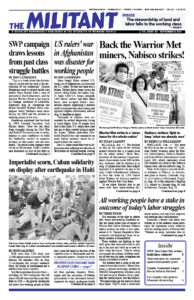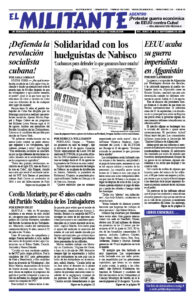September 9, 1996
Thousands of students in South Korea engaged in a nine-day confrontation with the government authorities, demanding reunification of the Korean peninsula. The protests began with a demonstration of 7,000 students in Seoul August 12. The rally was a commemoration of the 51st anniversary of the victory of the Korean people in throwing off the yoke of Japanese colonial domination.
Reunification has been a central demand of working people and youth in Korea ever since the partition of the country by Washington and Moscow following World War II. The U.S.-backed South Korean regime, however, has striven to halt even the most minimal political contact with the North [DPRK].
Some 37,000 U.S. soldiers accompany a South Korean army of 650,000 troops deployed near the “demilitarized zone,” an area that separates the DPRK from South Korea.
September 10, 1971
An important victory in the fight for GI rights was registered July 28 when the Army brass dropped its plans to court-martial Pvt. Ed Jurenas for his role in publishing an antiwar newspaper, The Arctic Arsenal, at Ft. Greely, Alaska.
The Army was forced to retreat because of broad support mobilized in barely more than two months.
Pvt. Jurenas, like most GIs today, was opposed to the war at the time of his induction last year. A member of the Young Socialist Alliance, Jurenas entered the Army with the intention of exercising his constitutional rights to act on his opposition together with other GIs. He said so in a news conference just prior to being inducted.
The response of most GIs to the paper’s appearance on post May 20 was favorable and enthusiastic, but the brass immediately set out to suppress this legal expression of dissent.
September 7, 1946
The American imperialists revealed their true reactionary face when on August 29 an order was issued by Gen. MacArthur in Tokyo prohibiting “strikes, walkouts or other work stoppages which are inimical to the objectives of the military occupation.”
MacArthur directed the puppet Japanese authorities to break a three-day strike of seamen, coupled with a threat to use American occupation troops if Japanese authorities found “police force” necessary to man the five ships that were tied up.
On August 28, MacArthur had issued another decree banning “noisy, disorderly demonstrations” and threatened to put them down with American troops if this were deemed “necessary.” The Japanese government immediately got tough with unionized employees, threatening railway workers with “serious results” if they tried to demonstrate “the union’s strength.”

